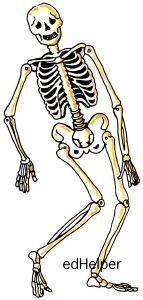1 Imagine you are outside trying on your new skates for the first time. You lose your balance and fall down. When you land, you hear a terrible cracking sound. Your arm looks crooked. Ouch! You broke a bone!
2 Bones are hard and tough. They are really not that easy to break, but they do break. A broken bone is serious and painful. The most commonly broken bones are the fingers, wrist, arm, and elbow. Why? It's human nature to try to break the fall! Did you know that more than 50% of Americans break a bone before they turn 18 years old? It's true!
3 Broken bones hurt, but there are actually no pain nerves inside your bones. So why do you feel pain? Well, the hard, white covering of the bone, which is called the
periosteum, is damaged when you break a bone. There are nerves and blood vessels inside the periosteum. They send the message to the brain, and then you feel pain.
4 A broken bone is called a
fracture. Most fractures are simple fractures. This is the kind of break where the bone doesn't go through skin. A compound fracture is the kind where a broken bone sticks through the skin. Sometimes children have incomplete fractures where the bone cracks, but the break doesn't extend completely through the bone. An impact fracture occurs when the broken ends of the bone are jammed together due to the force of the accident. A comminuted fracture is one in which the bone shatters. Finally, a person can have a single, double, or multiple fracture if there are one, two, or many breaks in the same bone.
5 The minute you break a bone, your body starts to fix it. Platelets come across damaged blood vessels, stick to them, and start trapping red blood cells. A clot forms and fills in the gap of the broken bone. This becomes the framework to form new bone and heal the fracture. Meanwhile, the tissue around the broken bone can become inflamed, and the skin will become red. White blood cells take care of the dead cells and germs. Bone cells remove dead parts of the bone and lay new material called a
callus. It will form the true bone.
Paragraphs 6 to 11:
For the complete story with questions: click here for printable







